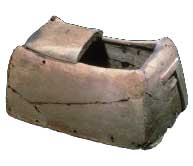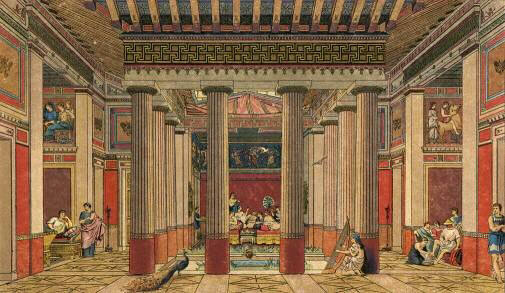Throughout Ancient Greece, houses came in two forms: the northern and southern styles. These two types of Ancient Greek Homes varied by material, structure, location, and culture. Ancient Greek cities were protected by stone walls. Inside them, most of the land was occupied by private homes.

What did a house mean in Ancient Greece?
The Ancient Greek houses was a place of pride for the man of the family. It was within these four walls that no one was allowed to treat him with any sort of disrespect.
The heart of a man was his house where he was bound to protect all of the living and not-living beings of the house. This was a huge worry for the house owners in ancient Greece.
War, as well as work, would keep the man away from the house and hence threats of intruders would fill in the minds of the men. In ancient Greek homes, there were barely any security measures and hence there was huge pressure of protecting the house from other neighbouring men.
Here we come across the Greek word, Oikos which basically means the space over which the man has sole responsibility and one which he has to protect so that the future generations can live there.
The ownership of the Greek Houses
In the ancient Greek times, men were the only ones who were allowed to own any sort of land. Which in turn left a mark for the homeowner’s son (male) to see? When the man of the household would pass away then the son would have to take over the entire household and would have to carry out tasks just like his father.
What were the houses made of?
Most ancient Greek houses were made of bricks made of clay and wood, with stone also being used in certain areas depending on the availability of materials. The bricks used were sun-dried and in certain homes, wooden structures were used as frameworks which were then filled with straw or sea before being covered by plaster or clay.
Stone was used as the foundation of the houses to protect them from moisture and collapse while the roofs were thatched with eaves.
These items were used especially keeping in mind the hot and humid temperatures of the Mediterranean which were warm all around the year. They did not have any modern inventions and had to rely on their architectural patterns to keep them cool.
The floors were sometimes tiled to keep them cool while straw was used to cover the windows as shutters to keep away the heat of the sun.

Furniture in Ancient houses
The Greeks had a very limited amount of furniture in their houses. The rooms were relatively bare by today’s standards. The Greeks used practicality to furnish their houses and they also borrowed some Egyptian techniques to build the furniture.
But doesn’t really have much information about the ancient Greek house rooms but then from what we have gathered, we can tell that the furniture which was present in all the different rooms would make that room unique and distinct from the others.
Their homes would consist of various stools and chairs and unlike our spring mattresses today, their beds would be very basic. Their home furnishings consisted of countless stools and chairs, some of which borrowed the folding X-frame from the Egyptians; a bed was made out of a thick board on four legs with a blanket, or by weaving string across of wooden frame, and chests were used in place of cupboards.

Mattresses were made of sacks filled with leaves, which was actually comfortable to the people at the time. Wooden chairs, couches, and stools were typical. The Greeks stored things in wooden chests or hung them from wooden pegs on the walls.
A rich home would also have a dresser to display expensive cups. People reclined on couches (which could also act as beds). The coaches were simply wooden frames with rope webbing and mats or rugs lay on top.

Ancient Greek Houses for The Poor
The poor lived in single-storied houses made of clay or mud which were often damaged due to natural factors and needed constant repairs. The roofs were made of straw with windows being small and placed at a height with no covers.
The homes were crammed with close to ten people living in two and at most three rooms in which there were no kitchens and the food was cooked outside on campfires.
Ancient Greek Houses for the Rich
The houses of the rice were quite spacious and large which housed not only their family but also all their slaves. The bonuses were decorated with mosaics and the roofs were also tilled which offered insulation. Shutters were also used on windows to keep them warm in the winter.
The houses were often double storied which consisted of a large courtyard surrounded by spacious rooms built with stones, tiles and pebbles.
Ancient Greek House Styles Plan
Ancient Greek Houses basically were in two different styles. The northern style and the southern style, the difference between these two homes was the material with which they were made, the location as well as the culture.
The houses were planned around a courtyard and had high walls and a strong gate. Much of ancient Greek family life centered on the courtyard. On bright, sunny days, women probably sheltered under a covered area of their courtyard, as the ancient Greeks believed a pale complexion was a sign of beauty.
Ancient Greek Homes were divided into areas for the men and areas for the women. The acorn was a room reserved for males to entertain male guests. The room had a separate entrance to the street so male guests did not have to cross paths with any of the ladies of the house.
Since there is a lack of complete information, historians have made various assumptions on what the houses were like. Their research has shown that the ancient Greek houses used to have rooms which resemble the present day main hall, entrance, second entrance, courtyard, upper floors and also public rooms which used to surround the courtyard.
Evidence has shown that these houses contained rooms equivalent to the main hall, courtyard, staircase, entrance, second entrance, upper floor for guests and slaves, and a number of public rooms that border the courtyard.
Rooms in Ancient Greek homes
- Andron: It was a room which was reserved only for men who used it for entertainment or business and also interacted with friends. The most luxurious furniture was placed in this room.
- The Gynaikon: It was placed mainly on the second floor and reserved only for the women in which they entertained their female guests and also used for spinning and weaving along with looking after the children.
- The workroom: It was second a storeroom to preserve food and wine along with jewellery, clothing and sandals.
- Kitchen: The kitchen only featured in the rich household which had a central hearth for heating and cooking on the fire. It consisted of a hole to let out the smoke generated in cooking.
- The bedrooms: It was the most basic room consisting of simple beds. There were two types of bedrooms. First for the house owners and another for the slaves which were even simpler without a bed but a cot laid out on the floor.
- The bathroom: The bathrooms consisted of a bathtub and a chamber pot instead of the modern commode. People brought in the water from wells or public fountains as bathrooms did not have a source of water.